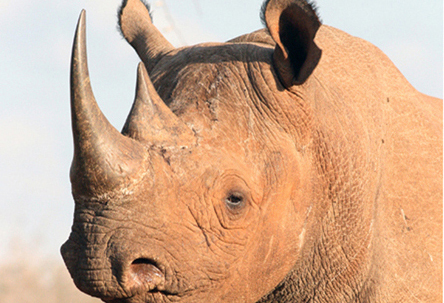The fate of the rhino may rest on the decision of whether or not to allow commercial trade in rhino horn.
In the early twentieth century, there were an estimated half million rhinos on Earth. By 1970, there were approximately 70,000 and, today, only about 28,000 rhinos survive in the wild. All five species of rhinoceros are listed on the International Union for the Conservation of Nature’s (IUCN) Redlist, with three out of five species listed as “critically endangered.” Although these animals have roamed the earth for 40 million years, their fate is now inextricably tied to global trade decisions, one more indication of how much their world and the world of wildlife conservation itself have changed.
Humans, for medicinal and aesthetic reasons, have coveted rhinoceros horn for thousands of years; a lust for rhino horn is nothing new. In Greek mythology, rhino horn was believed to facilitate water purification. In the fifth century AD, ancient Persians believed the horn could be used to detect poisoned drinks. This belief found favor in the royal courts of Europe and persisted among Europe’s elite into the eighteenth and nineteenth centuries. In China, the ornamental use of rhino horn dates back to at least the seventh century. In the sixteenth century, Chinese pharmacists prescribed dissolved rhino horn powder for snake bites, hallucinations, typhoid, headaches, vomiting, and “devil possession.” Of course, we now know these claims of medicinal powers for rhino horn are completely false. Currently, it is illegal to trade in rhino horn, though it remains more valuable per ounce than gold. According to IUCN’s African Rhino Specialist Group, since 2008, poachers have killed at least 5,940 African rhinos for their horns—nearly two animals per day on average. Despite intensified enforcement efforts, public awareness campaigns, global petitions, celebrity advocacy, increasing media attention, and political pressure, the situation with rhino poaching has reached a crisis point. It is likely that somewhere, as you read this, a dead or dying rhino is being defaced with a chainsaw for its horn.
Rhino horns are made of keratin, the same material found in human hair and fingernails. The center consists of dense calcium deposits and melanin that strengthen and protect the horn against sun exposure. While extensive testing has determined there is no medicinal value associated with its consumption, rhino horn remains a common and prized ingredient in traditional Chinese medicine (TCM), which is now practiced in seventy countries outside China and Southeast Asia. In TCM, rhino horn is used in combination with Chinese herbs to reduce “hot blood,” balance body temperature, eliminate toxins, and reduce fevers. In 1993, the Chinese government banned trade in rhino horn as part of an ongoing effort to end the use of endangered species in traditional Chinese medicine. Taiwan and South Korea followed suit and also implemented bans. Despite this, many traditionalists continue to use rhino horn because their ancestors used it and reported success.
Cultural practices die hard, don’t they? However, even ancient Chinese medical texts suggest botanical substitutes for rhino horn in the manufacture of traditional remedies. To leverage this cultural alternative, partnerships between TCM practitioners and international conservation communities have grown in recent years. Many representatives are now working together to educate practitioners and consumers about the availability of acceptable substitutes for rhino horn. At the same time, they work to inform people of the conservation impacts of poaching and illegal trafficking of endangered animals.
While this strategy offers some hope for a decline in the use of rhino horn in traditional Chinese medicine, two new markets have recently emerged to reinvigorate demand, and both are concentrated in Vietnam. Just ten years ago, there was no evidence of rhino horn use in that country. However, in the last decade, the nation has experienced rapid economic growth, an increase in disposable income, and a rapid increase in cancer rates. Vietnam now appears to be the leading destination for illegal rhino horn, which is being promoted in that country as a cure for cancer. IUCN’s Wildlife Trade Monitoring Network, TRAFFIC, refers to this as a “sensational urban myth.” Rhino horn has also been popularized in Vietnam as a “hangover cure” for the nouveau riche, increasing its value as a status-conferring gift or bribe among Vietnam’s elite. While TRAFFIC does report arrests of Vietnamese nationals involved in illegal trade and pseudo-hunting of rhino in South Africa, no seizures of illegal rhino horn have been made in Vietnam itself since 2008, suggesting the country is doing little to police the illegal trade within its own borders. To emphasize this point, in 2010, the Javan rhino became extinct in Vietnam, the last known animal having been shot and its horn removed presumably to feed the illegal market flourishing there.
With a great international demand fueling a thriving black market, many have asked the question, “Why not make rhino horn trade legal? Regulate it, and render poachers and their illegal trade irrelevant.” After all, you don’t actually have to kill or even harm a rhinoceros to harvest its horn. It typically takes less than ten minutes to safely dehorn a tranquilized rhino and the horn grows back and can then be trimmed or harvested regularly, typically every twelve to twenty-four months. Furthermore, dehorning is, in itself, an effective disincentive to poachers. So, legal horn trade and rhino conservation would seem to make perfect partners.
International trade in rhino horn was a hot topic at this year’s CITES Convention of the Parties (CoP). CITES is the Convention on International Trade in Endangered Species of Wild Flora and Fauna. Established in 1975, it represents a binding international agreement established between 175 countries whose aim is to ensure that international trade in wild animals and plants remains sustainable and does not threaten their survival. CITES imposed its first global ban on international trade in rhino horn in 1977.
In October this year, at CITES CoP17, Swaziland, a small and financially strapped African nation, proposed reopening its trade in rhino horn. The country presented a plan that included the immediate sale of 700 pounds of its stockpiled rhino horn, which would generate an estimated income of $10 million USD, followed by subsequent sales of 44 pounds per year during each year to follow. According to the plan, 44 pounds per year could easily be harvested from live rhinoceroses as part of ongoing antipoaching (dehorning) efforts. Without monetizing its rhino horn stocks, Swaziland pointed out, it might soon be unable to continue its antipoaching measures.
Despite the fact that most rhino range countries, like South Africa, Namibia, and Zimbabwe were in support, many wildlife advocates condemned the idea and a strong majority rejected Swaziland’s proposal. Moreover, CITES members voted to reject all proposals to sell rhino horn (and elephant ivory), whether seized from poachers, obtained through natural deaths, euthanasia of problem animals, or harvesting from live animals. Why? Because many conservation groups share the view that any legal trade would stimulate demand, allow legal trade in horn to provide cover for illicit trade and thus complicate law enforcement efforts. They further point to well-known political corruption in a number of selling and buying countries, and express strong doubts that legal regulation is even possible.
Advocates for legal trade argue differently, insisting that rhino horn is a renewable resource. They believe legalizing international trade would entirely undermine the black market, establish legitimate use and trade, promote economic growth, and positively impact human livelihoods in some of the world’s poorest countries, and do all this without negative conservation consequences. If the sale of horn were legal, advocates argue, rhino ranching would yield more profit per hectare than any other form of agriculture, thus safeguarding wildlife habitat, while simultaneously producing incentives and funding for conservation efforts. Those who are pro-trade also cite advances in DNA technology, which now make it possible to track a horn or its parts from rhino to consumer, thus increasing the likelihood of effective monitoring and trade regulation.
Both sides make compelling arguments. And while both sides also agree that more law enforcement is needed, both agree that enforcement alone is not enough. We need something more and that something is an incentive to keep living rhinos with us; not incentives to poach them. Sustainable use and legal trade have proven manageable and effective incentives globally for conserving many wildlife species. Why not for rhinos? Trading their horn legally may be a tough choice for some, but may well be our only hope. Losing our fight to save rhinos is no choice of all.











